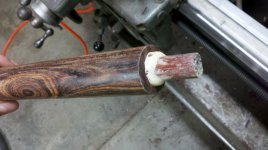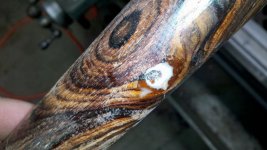I center drilled the coco, but i think the center drill was too big. The gun drill kept trying to walk when it hit the hole. I think if i use a smaller center drill it will be better. I didnt have any tear out, maybe i just got lucky. Ill follow your advice next time man. Thanks for the info! :thumbup:
Joe
You must bore a starter hole. Center drill the end of the piece and then drill a 1/2 inch hole about 1 inch deep. Then bore the hole until the head of the gun drill just slips in the hole.
This gives the gun drill a centered start. As soon as the gun drill goes past the starter hole it makes its own "bore" that keeps it on track.
On a piece longer than the gun drill, bore a hole on both ends and drill from both ends. The holes should meet perfectly in the middle.
Some people bore both ends to avoid splitting out when the drill exits the other end. I only do this on ebony because it is a little brittle. I have never had any split.
I run 40 lbs of air on the drill. Feed slow if you are using a dc motor as the controller will heat up and trip out. The motor can take it but the controller seems to be a little light.
I have a 1/2 hp ac motor I use on tough stuff. Curly maple seems to be the worst to drill and requires the most torque. PM me if you want some pics of the AC motor set up.
Kim


